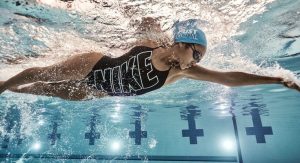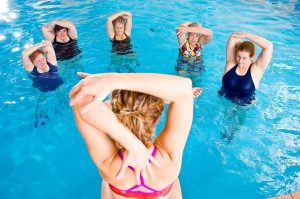How Many Laps Is A Mile Swimming
The number of laps in a mile when swimming depends on the length of the pool. In a standard 25-yard pool, a mile is equivalent to 1,650 yards, so it would take 66 laps to swim a mile. In a 25-meter pool, a mile is 1,609.34 meters, which is roughly 64 laps. If you are swimming in a 50-meter pool, a mile is 32 laps.
It’s essential to know the specific length of the pool to determine the number of laps needed to swim a mile.
In the vast ocean of fitness activities, swimming stands out as a refreshing and rewarding exercise. The rhythmic strokes, coupled with the resistance of water, make it an excellent full-body workout. Amidst the splashes and strokes, the question of the distance covered becomes a natural curiosity for swimmers.

Understanding Lap Measurements
Before we dive into the specifics, it’s crucial to understand what constitutes a lap in swimming. A lap is typically considered as one length of the pool, from one end to the other and back. However, the measurement of a lap can vary depending on the pool’s dimensions. Read more about https://peerlifestyle.com/what-to-do-on-a-rainy-day/
The Standard Mile
To answer the central question, we must first establish the standard measurement of a mile in swimming. In most cases, a mile is equivalent to 1,650 yards or 1,500 meters. In a standard 25-yard pool, this translates to approximately 66 laps, considering one lap as one length of the pool.
Factors Affecting Lap Count
How many laps is a mile swimming lap count is not a one-size-fits-all metric. Several factors can influence the number of laps it takes to complete a mile, including the size of the pool, individual swimming abilities, and the specific strokes used during the swim. For more information visit our website peerlifestyle.com
Popular Swimming Events
In the competitive swimming arena, lap counting takes center stage. Olympic swimming competitions showcase the pinnacle of athleticism, with swimmers covering remarkable distances in pursuit of victory. Marathon swims and challenges also contribute to the diversity of swimming events, emphasizing the endurance and determination required in the sport.
Tracking Swimming Progress
For swimmers looking to enhance their performance, keeping track of laps becomes essential. Setting goals and gradually increasing lap counts can be a motivating way to measure progress. In the era of technology, various tools and devices are available to aid in accurate lap counting.
Tips for Beginners
If you’re new to swimming, setting realistic lap goals is key to building endurance and stamina. Gradually increasing the lap count allows for a steady progression, preventing burnout and injuries.
Advanced Swimmers and Training
For advanced swimmers, incorporating high-intensity interval training (HIIT) can be a game-changer. Strategic approaches to increasing lap counts, coupled with efficient techniques, contribute to a more effective and challenging workout.
Common Misconceptions
Dispelling myths is crucial in understanding lap counting in swimming. Not all pools have the same lap length, and lap count is just one measure of success. Factors like swim strokes and techniques also play a significant role in achieving fitness goals.
Health Benefits of Swimming
Beyond lap counting, swimming offers a plethora of health benefits. The cardiovascular advantages, coupled with the full-body workout, make it an ideal exercise for overall well-being.

Personal Experiences
Real-life stories of swimmers achieving lap milestones can be highly motivational. These testimonials serve as a source of inspiration for those aiming to push their limits in the water.
Competitive Swimming Records
In the competitive realm of swimming, lap counting is pivotal in breaking records. Current records in various swimming categories highlight the extraordinary feats accomplished by athletes worldwide.
Community and Social Aspects
How many laps is a mile swimming isn’t just an individual pursuit; it’s also a communal activity. Group swims and lap challenges foster a sense of community, connecting swimmers worldwide. Online platforms further enhance this sense of camaraderie, allowing individuals to share their achievements and experiences.
Celebrating Milestones
Achieving lap milestones is a cause for celebration. Whether it’s completing the first mile or reaching a personal best, recognizing these achievements contributes to the overall joy of swimming. Rewards and recognitions further motivate swimmers to set and conquer new lap goals.
Conclusion
In conclusion, the question of how many laps make a mile in swimming is multifaceted. It depends on various factors, including pool size, individual abilities, and swimming techniques. Regardless of the specifics, swimming offers a dynamic and engaging way to stay fit. Setting lap goals, tracking progress, and celebrating achievements add a layer of motivation to this already enjoyable exercise.
FAQs
- Is lap counting the same in all swimming pools?
- No, lap counting varies based on the dimensions of the pool. Different pools have different lengths, affecting the lap count for a mile.
- Can lap counting be done manually?
- Yes, swimmers can manually count laps, but technological aids like swim watches and fitness trackers offer more accurate and convenient options.
- What is the significance of HIIT in lap counting for advanced swimmers?
- High-intensity interval training (HIIT) in swimming can improve endurance and contribute to increasing lap counts by incorporating intense bursts of activity.
- Are there online communities for lap challenges?
- Yes, many online platforms and communities encourage lap challenges, allowing swimmers to connect, share experiences, and motivate each other.
- How often should beginners increase their lap count?
- Beginners should aim for gradual increases in lap count, considering factors like fitness level and comfort in the water. A steady progression is key to preventing overexertion.

